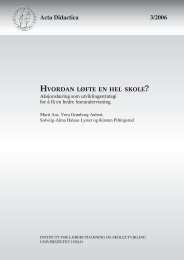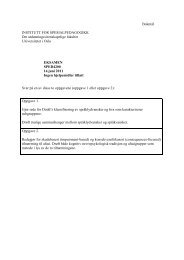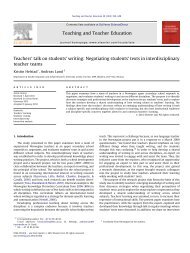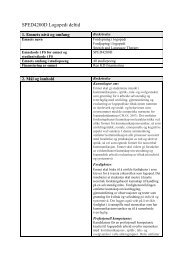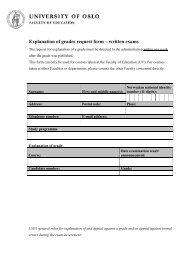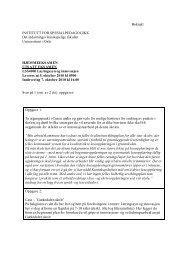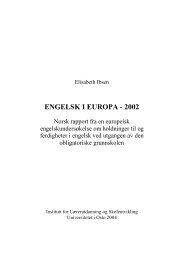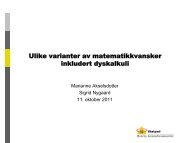International Journal Special Education
International Journal Special Education
International Journal Special Education
Create successful ePaper yourself
Turn your PDF publications into a flip-book with our unique Google optimized e-Paper software.
INTERNATIONAL JOURNAL OF SPECIAL EDUCATION Vol 26, No: 3, 2011not utilize chess as a pedagogical tool. It should be noted that unlike the treatment campus, this campushad an active chess club. To control for possible confounding variables, the students enrolled in thecomparison class who played chess were expunged from the data by the campus registrar.ResultsIn order to test the hypotheses for this study, an analysis of covariance (ANCOVA) was conducted tocompare the adjusted mean scores for each of the three dependent measures. In accordance with Scholzet al. (2008), the students’ grade level and pretest scores served as covariates to control for errorvariance. In order to reject the null hypotheses and accept the research hypotheses, F ratios weremeasured at the alpha = 0.05 levels of significance. With data from 31 participants eligible for analysis,the cutoff score for the F distribution was 4.17.The design of this study measured math achievement with two forms of instrumentation: the end-of-yearcourse grades in resource math and the math TAKS. There were eight measures of student achievementthat were analyzed: the students’ end-of-year course grades in their resource math classes, the students’overall scale scores on the math TAKS, and the students’ percentage scores on each of the sixmathematic objectives on the TAKS: (a) Numbers, Operations, and Quantitative Reasoning; (b) Patterns,Relationships, and Algebraic Reasoning; (c) Geometry and Spatial Reasoning; (d) Concepts and Uses ofMeasurement; (e) Probability and Statistics; (f) Mathematical Processes and Tools. These scores weretested at the alpha = 0.05 levels of significance with a critical F value (1, 30) = 4.17. Table 3 highlightsadjusted mean scores for 2009 measures of math achievement.End-of-Year Course GradesThe results of this study indicated a significant difference between the end-of-year course grades forstudents in resource math classes who received weekly chess instruction and students in resource mathclasses who did not receive weekly chess instruction. Participants’ final grades from the 2007-2008academic year served as the pre-test measure. Prior to an analysis of covariance, Levene’s Test ofEquality of Variances was calculated. Results were not significant (F = 0.101, p = 0.753). Thus, the nullhypothesis that the error variance of the dependent variable would be equal across groups was accepted;homogeneity across the two groups was assumed. The mean 2008 pre-test scores for the two groupswere as follows: the comparison group had a mean final grade of 84.25 (SD = 6.748) and the treatmentgroup 87.53 (SD = 6.379). The 2009 post-test means were 79.94 (SD = 4.582) for the comparison groupand 88.73 (SD = 4.891) for the treatment group. Using grade level and pretest measures as covariates, anAnalysis of Covariance (ANCOVA) analyzed the adjusted mean scores (comparison = 80.61; treatment= 88.02) for students from the two groups with the alpha = 0.05. Results showed a statisticallysignificant relationship between the independent variable, chess instruction, and the dependent measure,end-of-year course grades (F = 19.40; p < 0.001).In order to test the power of the statistical significance, a partial eta squared was calculated yielding amedium sized effect for the independent variable (partial η² = 0.418).Math TAKS Scale ScoresSignificant differences existed between the math TAKS scale scores for students in resource math classeswho received weekly chess instruction and students in resource math classes who did not receive weeklychess instruction. Participants’ math TAKS scale scores from the spring of 2008 (first administrationonly) served as the pre-test measure. Prior to an analysis of covariance, Levene’s Test of Equality ofVariances was calculated. Results were not significant (F = 0.317, p = 0.578). Thus, homogeneityacross the two groups was assumed.The mean 2008 pre-test scores for the two groups were as follows: the comparison group had a meanscale score of 2097.94 (SD = 119.148) and the treatment group 2126.80 (SD = 152.931). The 2009 posttestmeans were 2083.75 (SD = 85.106) for the comparison group and 2192.73 (SD = 104.795) for thetreatment group. Using grade level and pretest measures as covariates, an Analysis of Covariance(ANCOVA) analyzed the adjusted mean scores (comparison = 2084.75; treatment = 2191.67) forstudents from the two groups with the alpha = 0.05. Results showed a statistically significantrelationship between the independent variable, chess instruction, and the dependent measure, mathTAKS scale scores (F = 9.167; p = 0.005). In order to test the power of the statistical significance, apartial eta squared was calculated yielding a moderate sized effect for the independent variable (partial η²= 0.253).188



